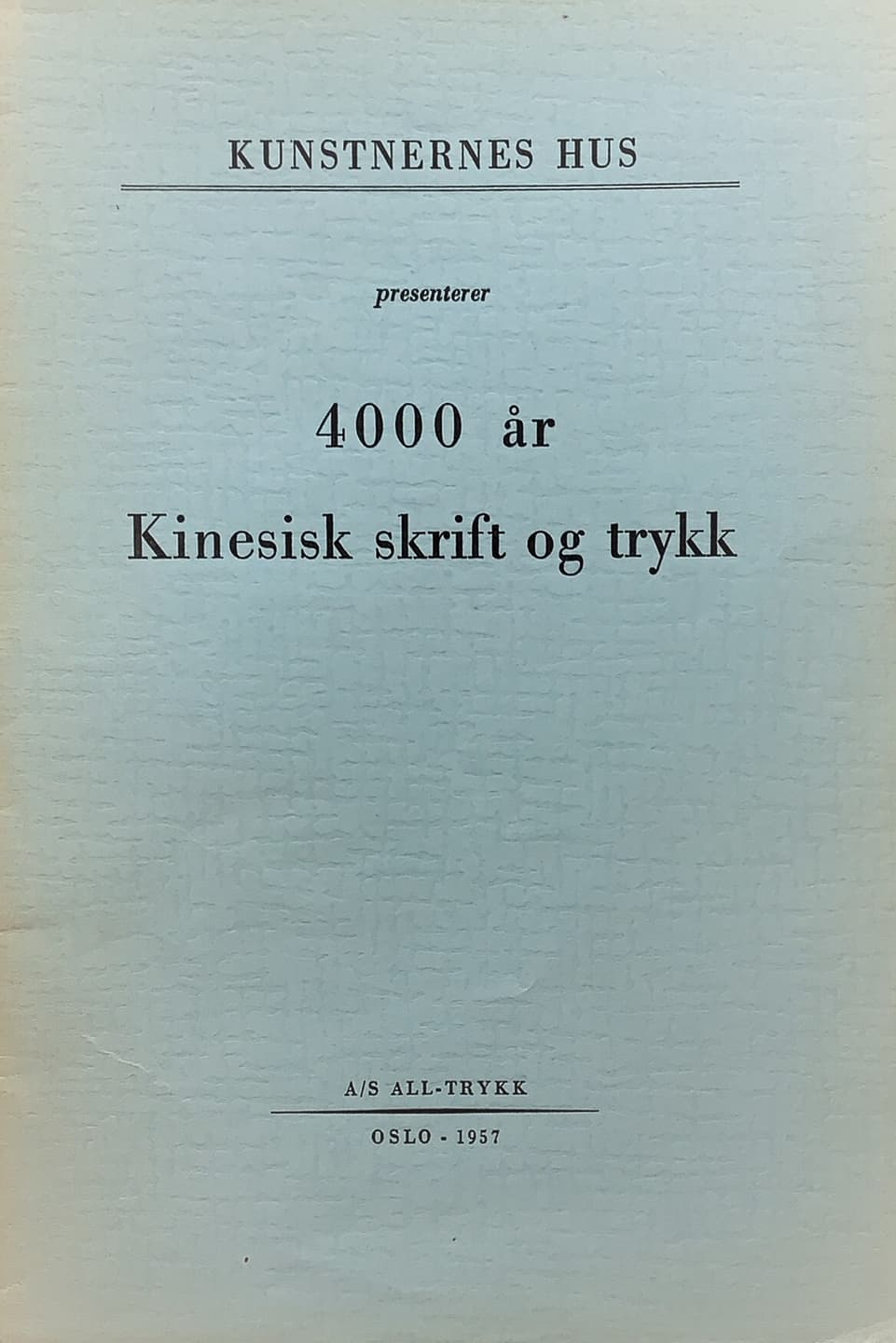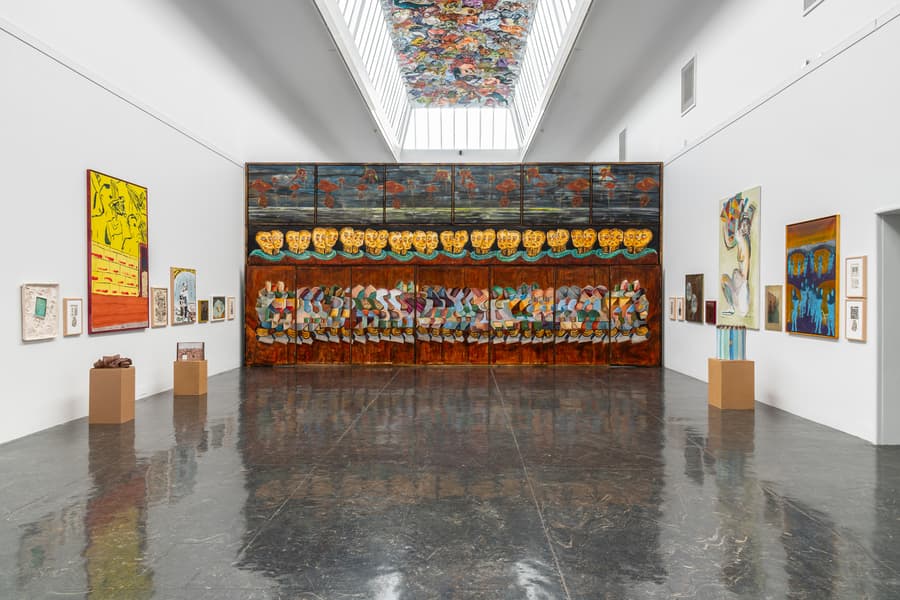4000 years with Chinese writing and painting

Chinese writing and printing
PART 1: OLD BOOKS
It is a well-known fact that both paper and the art of printing were Chinese inventions from the start. These two inventions have made valuable contributions to the development of human culture.
Before paper was used in China, the writing characters were engraved on the shield of the land turtle and on animal bones: these were the so-called "oracle bone inscriptions", which were excavated in the "Yin Desert" at Anyang, Honan Province in the North China, where the capital was located in the last part of the Shang Yin dynasty (1766-1122 BC).
Writing was sometimes shaped or engraved on bronze vessels: such writing is usually known as bronze inscriptions. Writing was also carved in stone and we have preserved to this day such old stone inscriptions as the "Stein drums" from the Ch'in dynasty (225-206 BC) and the "Stein classics" from the later part of the Han dynasty (25-221 AD), the Wei dynasty (220-265 AD) and the T'ang dynasty 618-907 AD).
But the most important and most used materials for preserving written records in ancient China were bamboo and wood. Books, in the sense we usually understand this word, were put together from narrow strips of bamboo or wood, known in China under the name «Chien tu».
We now know that paper came into use in China at least as early as the year 12 B.C. In the year 105 AD, during the Han Dynasty, Ts'ai Lun invented improvements in papermaking and gifted the country with a new type of paper that could be produced in large quantities. The invention of paper and the widespread use of this material soon led to books made of strips of bamboo and wood having to give way to books consisting of paper rolls ("Mahaparinirvana-sutra" and "En Dharani"). The large number of ancient manuscripts dating from the end of the 4th to the 10th century and discovered in the Caves of the Thousand Buddhas at Tunhuang in Kansu Province, Northwest China, were products of what we can call the "Age of Scrolls" ».
Currently, the earliest known example of three-panel printing is part of a printed page from the 6th century. From this time on, printing was gradually used for many different purposes and the quantity of printed materials also grew. From the 10th to the 14th century, centers of plate printing grew up in various parts of the country, besides Pien-liang (present-day Kaifeng in Honan Province), there were also Hangchov in Chekiang Province, Chien-yang in Fukien - province, Mei-shan in Szechuan province and P'ing-yang (P'ing-sui) in Shansi province significant centers. Pien-liang and Hangchow were in turn the capitals of the Sung dynasty (960-1280 AD). Chiengyang was a center for paper production and Szechuan was already as early as the 9th century a center for plate printing. But it wasn't just in these better-known centers that plate printing was done, a number of books were also printed in other parts of China.
From the 15th century onwards, more and more books were printed in the various cities of China. In Peking and Nanking, which were the capitals of the Ming dynasty (1368—1644) and the Ch'ing dynasty (1644—1911), the art of book printing flourished as never before. At the same time, large encyclopedias and collector's works were published and printed, such as "Yung Lo encyclopedia" from the Ming dynasty and "Complete library in four parts" from the Ch'ing dynasty, on a scale that was previously quite unknown. Modern facsimile reproductions of selected volumes from these two mammoth works are included in this exhibition («Yung Lo encyclopedia» and «Complete library in four parts»).
In the middle of the 11th century, Pi Shen invented a new way of printing, using types of burnt clay, which is also a Chinese invention, and later it became types of wood and metals. Among the items in this exhibition, "The Chinese Encyclopedia" and "Collection of Works Printed on Types in the Wu Ying Hall" were printed in the 18th century, the former with copper types, the latter with three types. Such large books had never been printed before, because the "Encyclopedia" comprises 5,020 volumes, while the "Collection" contains 134 different works, spread over almost 1,000 volumes.
The woodcut was developed early in China. The vignette for the "Dianman Sutra", carved by Wang Chieh in 868 AD, shows that the art of woodcuts had already come a long way at this time. After this time we find many Buddha sutras, dramas, novels and scientific works illustrated with woodcuts that are both lifelike and beautiful.
While books with text and notes were already printed in two colors (black and red) in the 14th century, it was not until the 16th century that multi-colored images in three-panel printing were made. At first the printers smeared the different colors on a single board and printed on it, but later the method of printing each color with a special board was discovered. Towards the end of the Nling Dynasty, i.e. in the middle of the 17th century, Hu Cheng-yen used this method as well as the newly discovered method of raised printing to produce his "Album of Wonderful Writings from the Ti-Bamboo Studio". By using different boards, one could print different colors and shades of color at the same time as figures appeared in raised print. At this time, woodcuts were not only used to print illustrations in books, but also for painting reproductions.
In the last fifty years, colored woodcuts have once again become very popular. "Collection of Fantastic Writings from Peiping", edited by Lusin and Cheng Chen-to, is an outstanding and representative example from this period.
The modern printing technique was introduced in China in the middle of the 19th century. Not only new books, but also some of the old classical and canonical works have been reprinted on a large scale using modern technology, and this contributes to a high degree to promoting the cultural movement and scientific research in China.
2. PART. «MODERN CHINESE BOOKS AND JOURNALS
It has been over 7 years since the People's Republic of China was formed. Starting in 1953, the Chinese people entered a new historical period, the first five-year plan for the development of the national economy. The steadily increasing cultural activity in the country finds its expression in the constant publication of more and more printed works. In 1954, a total of 939,962,000 books, 204,933,000 magazines and 1,710,848,000 newspapers were printed. In addition to this, the countless national minorities in China have developed their own economy and culture during the last 6 years, by their own efforts and with the fraternal assistance of the main Han nationality. As a result, the number of books, journals and newspapers published in the languages of the national minorities has increased considerably. In 1954, approximately 29,118,000 copies were published. All these are results that have never before been achieved in China.
Some of what was published in New China is on display here.
There are editions in various languages of the Constitution of the People's Republic of China, adopted at the first meeting of the First National People's Congress of China on September 20, 1954. Here you can also find works by Mao Tse-tung, printed and published in limited editions. His important works have been and will be translated into the languages of the various minorities and into the most important other languages in the world. These books have been improved in many ways, both in terms of corrections, printing and binding. Part of what is on display here consists of works in the natural sciences, historical works, linguistic works, etc., written by such outstanding scientists as Kuo Mo-jo and Hun Lo-keng, as well as literary works by prominent novelists and novelists in the modern China. Here are selected works by Lu Hsun, facsimiles of manuscripts of his diary, Ting Ling's "The Sun Shines Over Sangkan Eleven", Chou Li-po's "The Hurricane", Tu Peng-cheng's "The Defense of Yenan" and the famous classic novels « Drømmen det røde kammer», «Strandbredden», «The Ballad of the Three Kingdoms», «Lærde mens liv», etc. Some of these books are photo reproductions of old woodblock editions, others are modern publications printed on woodblock or metal types.
Little by little, the valuable heritage of China's folk art and ancient literature has been rediscovered on a steadily larger scale. Such rich and brilliant art forms as the folk drama, papier-mâché and New Year's pictures (which are used for decoration during the New Year's celebration) have received new content and have become very popular among the masses. Thus E.g. «Selected operas, performed by Dr. Mei Lan-fang», «Liang Shan-po and Chu ying-tai» (Shaosing Opera) and «Ashma», the oldest of the Shani ballads, (the Shani people are a branch of the Yi people, one of the nationalities of China).
The exhibited reproductions of such famous works of art as Chi Pai-shi's watercolors, the colored woodcuts from the Ti-Bambous studio during the Ming dynasty and the reliefs of Tunhuang are done by the Jung Pao Chai art studio in Beijing. Reproduced from multi-colored plate prints using a very special process, these copies hardly match the original works in terms of style and atmosphere.
The publishers in China have also done a great deal of work to acquaint the Chinese people with foreign literature. The Chinese translations of Pushkin, Gorky, Balsac, Romain Rolland, Shakespeare, Hugo, Tolstoy, Goethe and Ibsen's works, some of which are exhibited here, represent only a small part of the translations of foreign literature that you have published during the last 7 years .
The people of China support peace and defend friendly cooperation and cultural exchange between nations. A selection of New China's publications in foreign languages is on display here.
There can be no doubt that the rapid development on the book front is inextricably linked to the progress that the Chinese people have made in economic and cultural development. Today, the books have become the property of the people, and as they reach the remote and remote areas of the country, they will gradually become a part of their lives as well.


